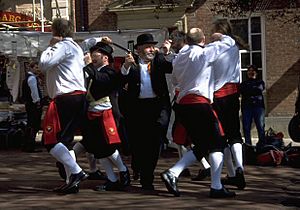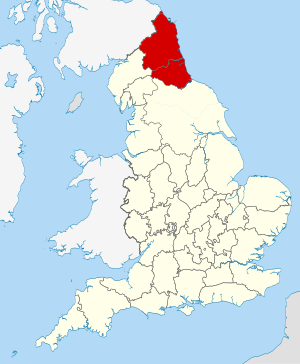Rapper sword facts for kids

The Rapper sword dance, sometimes called the short sword dance, is a special type of sword dance. It comes from the areas of Northumberland and County Durham in England. This dance started in the mining villages of Tyneside and Wearside, where miners first performed it.
Five dancers are needed for this exciting performance. They work together using "rapper swords," which are made from flexible steel. The dance is set to traditional folk music. Dancers wear shoes with hard soles to make rhythmic foot sounds, like a drum. Dancers need to be very focused and quick to use the swords safely and avoid hurting themselves or others.
Contents
History of Rapper Sword Dancing
We don't have many old records about how the rapper sword dance began. However, experts now believe it started in the mining villages of the Northumberland and Durham coalfields in North-East England. This dance was very popular in towns along the River Tyne and down the coast past Sunderland.
Older sword dances, using stiff longswords, were also performed in Yorkshire, Cumberland, and Teesdale. We know about a Yorkshire dance from a description written in 1715. Other old accounts mention sword dancing in Cumberland in 1787 and Teesdale in 1778.
At some point in the 1800s, the stiff swords were replaced with flexible rapper swords in the coal mining areas. We don't know exactly why this change happened. Some people used to think the flexible swords were for cleaning dirt from pit ponies, but there's no proof of this. It's thought that flexible steel became more available and cheaper after 1855, which might have helped the change.
The dance involves five people. Many performances include characters like Tommy and Betty. These characters announce the dance, entertain the audience, and collect money. The dancers are linked by short, flexible swords. These swords have two handles, with at least one handle fixed. The flexible rapper swords create an unbroken chain connecting all the dancers. This dance is similar to the Long Sword dance from Yorkshire and other sword dances found in Europe. Some of the earliest teams danced to hornpipes, but today they mostly use jigs.
Rapper in the 1800s
During the 1800s, rapper dance teams from the mining villages of Tyneside and Wearside would travel. They went to towns like Newcastle upon Tyne, Sunderland, and Durham. There, they performed for crowds and asked for money. This tradition was later used to earn money during miners' strikes and when mines closed for winter.
Sword dancers from the North East also took part in important political events. A team called Tyneside Rovers joined a march to parliament in 1890. Another team from Hebburn was part of the famous Jarrow Crusade in 1936. Teams also danced and collected money during the 1926 miners' strike and the Great Depression.
Rapper in the 1900s
By the early 1900s, the dance started to become less common. However, it gained new interest after Cecil Sharp wrote down five of the traditional village dances in his book, The Sword Dances of Northern England. After the First World War, the dance saw a big comeback. There was strong competition between pit villages in the rapper categories of the new North of England Musical Tournament in Newcastle upon Tyne.
After the Second World War, the dance slowly faded in the original mining villages. This was partly due to changes in those communities. But another revival began in 1949. Students at Kings College in Newcastle upon Tyne (now the University of Newcastle upon Tyne) started performing it. From there, the dance spread beyond its traditional home. Today, rapper teams around the world perform this tradition. They learn from written notes or from other dancers, continuing the old ways of teaching.
Rapper Today: The 2000s
The dance has changed as it moved into the 2000s. It's now much faster, performed at about 140–160 beats per minute. Different teams have their own styles and speeds. The dance is usually smooth and graceful, with one move flowing into the next. Dancers can even do amazing acrobatic moves, like somersaults over the swords!
Today, rapper sword dancing is almost always performed to jigs. The dancers often use a shuffle step, which comes from the local clogging tradition. Many different instruments can play the music, like fiddles, tin whistles, and accordions. Many of the jigs used today were likely brought by Irish and Scottish immigrants in the 1800s. The music is usually played by one person, or sometimes two.
The competitive side of rapper sword dancing has also returned. The Dancing England Rapper Tournament (DERT) is held every year in a different UK city. There's also a similar competition in America called the Dancing America Rapper Tournament (DART).
Costumes for Rapper Dancing
The special clothes worn for the dance are called the kit. This costume is a stylish version of what coal miners wore in the 1800s. It includes a shirt, a sash, breeks (short trousers), hoggers (even shorter trousers), or long trousers, and socks. Some older teams decorated their kits with ribbons or flowers. They might also add a tie or a waistcoat.
Modern teams use many different kits. Most are based on the traditional costume. Each team uses different color combinations to create its own unique look. Some modern teams, especially women's teams, use very different outfits.
Performances
Dancing in Pubs
Unlike some other traditional dances, Rapper Sword is often performed inside pubs. 'Rapper crawls' are often held on Friday nights. These events let the public, even those new to folk dance, see the dance live.
Performing in busy, noisy pubs means the comic characters, the Tommy and Betty (often just the Tommy), can explain the dance. They also interact with the audience, making the performance fun for everyone.
Dancing at Folk Festivals
Rapper sword teams also perform at folk festivals across the UK. A popular one is the Sidmouth Folk Festival.
DERT Competition
The Dancing England Rapper Tournament (DERT) is a competition open to all rapper sword teams. It happens every year in a different UK city or town. The tournament started with three main divisions: Premier, Championship, and Open. A youth competition called 'DERTy' was added later. A 'Traditional dance' class was also introduced to show the original dances and how they were performed.
| Event | Location | Hosts | Dates | Overall winner | DERTy winner |
|---|---|---|---|---|---|
| DERT 2014 | Leeds | Black Swan Rapper | 7–8 March 2014 | Star & Shadow | |
| DERT 2015 | Bristol | Northgate Rapper | 10–12 April 2015 | Newcastle Kingsmen | NYFTE |
| DERT 2016 | Manchester | Medlock Rapper | 11–13 March 2016 | Newcastle Kingsmen | Oakenyouth |
| DERT 2017 | Kendal | Crook Morris | 7–9 April 2017 | Newcastle Kingsmen | NYFTE |
| DERT 2018 | Sheffield | Sheffield Steel | 23–25 March 2018 | Whip the Cat | NYFTE |
| DERT 2019 | Newcastle | Newcastle Kingsmen, Sallyport Sword & Star and Shadow Rapper | 5–7 April 2019 | Newcastle Kingsmen | - |
| DERT 2022 | Derby | Stone Monkey | 26 March 2022 | Tower Ravens | - |
The DERT competition was postponed in 2020 and cancelled in 2021 due to the COVID-19 pandemic in the United Kingdom.
More About Rapper Dancing
The Rapper Online website has lots of information about the dance's history and different teams. You can also find notes on how to do traditional dances. "The NUT on the Net" is another great source for current and past information.
Some of the top teams in the traditional areas include the High Spen Blue Diamonds, the Newcastle Kingsmen, Monkseaton Morris Men, the Sallyport Sword Dancers, and Star and Shadow. The Sword Dance Union has a map showing where current UK teams are located.
Rapper dancing has become popular around the world! Jack The Rapper, from Norway, has attended DERT competitions. Teams from the United States, like Newhaven and Candyrapper, have also competed. Red Mum Rapper from Denmark has joined DERTs too. You can even find rapper teams in Australia, Germany, and the Basque Country of France.
See also



